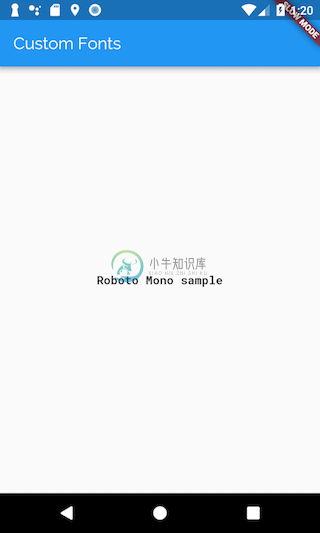Using custom fonts
While Android and iOS offer high quality system fonts, one of the most common requests from designers is to use custom fonts. For example, you may have a custom-built font from a designer, or maybe you downloaded a font from Google Fonts.
Flutter works out of the box with custom fonts. You can apply fonts across an entire app or to individual Widgets.
Directions
- Import the font files
- Declare the font in the
pubspec.yaml - Set a font as the default
- Use a font in a specific Widget
1. Import the font files
In order to work with a font, you need to import the font files into the project. It is common practice to put font files in a fonts or assets folder at the root of a Flutter project.
For example, if you want to import the Raleway and Roboto Mono font files into a project, the folder structure would look like this:
awesome_app/
fonts/
Raleway-Regular.ttf
Raleway-Italic.ttf
RobotoMono-Regular.ttf
RobotoMono-Bold.ttf
2. Declare the font in the pubspec.yaml
Now that you have a font to work with, you need to tell Flutter where to find it. You can do so by including a font definition in the pubspec.yaml.
flutter:
fonts:
- family: Raleway
fonts:
- asset: fonts/Raleway-Regular.ttf
- asset: fonts/Raleway-Italic.ttf
style: italic
- family: RobotoMono
fonts:
- asset: fonts/RobotoMono-Regular.ttf
- asset: fonts/RobotoMono-Bold.ttf
weight: 700
pubspec.yaml option definitions
The family determines the name of the font, which you use in the fontFamily property of a TextStyle object.
The asset is a path to the font file, relative to the pubspec.yaml file. These files contain the outlines for the glyphs in the font. When building the app, these files are included in the app’s asset bundle.
A single font can reference many different files with different outline weights and styles:
The
weightproperty specifies the weight of the outlines in the file as an integer multiple of 100, between 100 and 900. These values correspond to theFontWeightand can be used in thefontWeightproperty of aTextStyleobject.The
styleproperty specifies whether the outlines in the file areitalicornormal. These values correspond to theFontStyleand can be used in the fontStyle property of aTextStyleobject.
3. Set a font as the default
You have two options for how to apply fonts to text: as the default font or only within specific Widgets.
To use a font as the default, set the fontFamily property as part of the app’s theme. The value provided to fontFamily must match the family name declared in the pubspec.yaml.
MaterialApp(
title: 'Custom Fonts',
// Set Raleway as the default app font
theme: ThemeData(fontFamily: 'Raleway'),
home: MyHomePage(),
);
For more information on themes, please view the “Using Themes to share colors and font styles” recipe.
4. Use the font in a specific Widget
If you want to apply the font to a specific Widget, such as a Text Widget, provide a TextStyle to the Widget.
In this example, you’ll apply the RobotoMono font to a single Text Widget. Once again, the fontFamily must match the family name declared in the pubspec.yaml.
Text(
'Roboto Mono sample',
style: TextStyle(fontFamily: 'RobotoMono'),
);
TextStyle
If a TextStyle object specifies a weight or style for which is there is no exact font file, the engine uses one of the more generic files for the font and attempts to extrapolate outlines for the requested weight and style.
Complete example
Fonts
The Raleway and RobotoMono fonts were downloaded from Google Fonts.
pubspec.yaml
name: custom_fonts
description: An example of how to use custom fonts with Flutter
dependencies:
flutter:
sdk: flutter
dev_dependencies:
flutter_test:
sdk: flutter
flutter:
fonts:
- family: Raleway
fonts:
- asset: fonts/Raleway-Regular.ttf
- asset: fonts/Raleway-Italic.ttf
style: italic
- family: RobotoMono
fonts:
- asset: fonts/RobotoMono-Regular.ttf
- asset: fonts/RobotoMono-Bold.ttf
weight: 700
uses-material-design: true
main.dart
import 'package:flutter/material.dart';
void main() => runApp(MyApp());
class MyApp extends StatelessWidget {
@override
Widget build(BuildContext context) {
return MaterialApp(
title: 'Custom Fonts',
// Set Raleway as the default app font
theme: ThemeData(fontFamily: 'Raleway'),
home: MyHomePage(),
);
}
}
class MyHomePage extends StatelessWidget {
@override
Widget build(BuildContext context) {
return Scaffold(
// The AppBar uses the app-default Raleway font
appBar: AppBar(title: Text('Custom Fonts')),
body: Center(
// This Text Widget uses the RobotoMono font
child: Text(
'Roboto Mono sample',
style: TextStyle(fontFamily: 'RobotoMono'),
),
),
);
}
}


